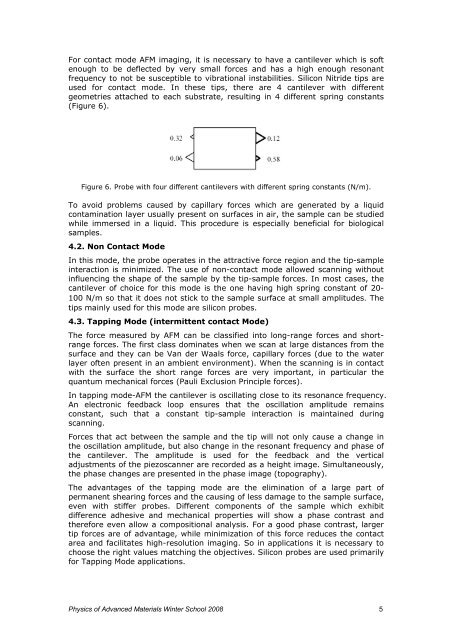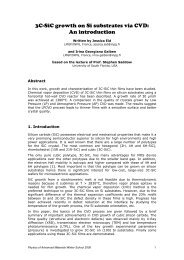Principles of Atomic rinciples Force Microscopy (AFM) - Mansic
Principles of Atomic rinciples Force Microscopy (AFM) - Mansic
Principles of Atomic rinciples Force Microscopy (AFM) - Mansic
Create successful ePaper yourself
Turn your PDF publications into a flip-book with our unique Google optimized e-Paper software.
For contact mode <strong>AFM</strong> imaging, it is necessary to have a cantilever which is s<strong>of</strong>t<br />
enough to be deflected by very small forces and has a high enough resonant<br />
frequency to not be susceptible to vibrational instabilities. Silicon Nitride tips are<br />
used for contact mode. In these tips, there are 4 cantilever with different<br />
geometries attached to each substrate, resulting in 4 different spring constants<br />
(Figure 6).<br />
Figure 6. Probe with four different cantilevers with different spring constants (N/m).<br />
To avoid problems caused by capillary forces which are generated by a liquid<br />
contamination layer usually present on surfaces in air, the sample can be studied<br />
while immersed in a liquid. This procedure is especially beneficial for biological<br />
samples.<br />
4.2. Non Contact Mode<br />
In this mode, the probe operates in the attractive force region and the tip-sample<br />
interaction is minimized. The use <strong>of</strong> non-contact mode allowed scanning without<br />
influencing the shape <strong>of</strong> the sample by the tip-sample forces. In most cases, the<br />
cantilever <strong>of</strong> choice for this mode is the one having high spring constant <strong>of</strong> 20-<br />
100 N/m so that it does not stick to the sample surface at small amplitudes. The<br />
tips mainly used for this mode are silicon probes.<br />
4.3. Tapping Mode (intermittent contact Mode)<br />
The force measured by <strong>AFM</strong> can be classified into long-range forces and shortrange<br />
forces. The first class dominates when we scan at large distances from the<br />
surface and they can be Van der Waals force, capillary forces (due to the water<br />
layer <strong>of</strong>ten present in an ambient environment). When the scanning is in contact<br />
with the surface the short range forces are very important, in particular the<br />
quantum mechanical forces (Pauli Exclusion Principle forces).<br />
In tapping mode-<strong>AFM</strong> the cantilever is oscillating close to its resonance frequency.<br />
An electronic feedback loop ensures that the oscillation amplitude remains<br />
constant, such that a constant tip-sample interaction is maintained during<br />
scanning.<br />
<strong>Force</strong>s that act between the sample and the tip will not only cause a change in<br />
the oscillation amplitude, but also change in the resonant frequency and phase <strong>of</strong><br />
the cantilever. The amplitude is used for the feedback and the vertical<br />
adjustments <strong>of</strong> the piezoscanner are recorded as a height image. Simultaneously,<br />
the phase changes are presented in the phase image (topography).<br />
The advantages <strong>of</strong> the tapping mode are the elimination <strong>of</strong> a large part <strong>of</strong><br />
permanent shearing forces and the causing <strong>of</strong> less damage to the sample surface,<br />
even with stiffer probes. Different components <strong>of</strong> the sample which exhibit<br />
difference adhesive and mechanical properties will show a phase contrast and<br />
therefore even allow a compositional analysis. For a good phase contrast, larger<br />
tip forces are <strong>of</strong> advantage, while minimization <strong>of</strong> this force reduces the contact<br />
area and facilitates high-resolution imaging. So in applications it is necessary to<br />
choose the right values matching the objectives. Silicon probes are used primarily<br />
for Tapping Mode applications.<br />
Physics <strong>of</strong> Advanced Materials Winter School 2008 5




